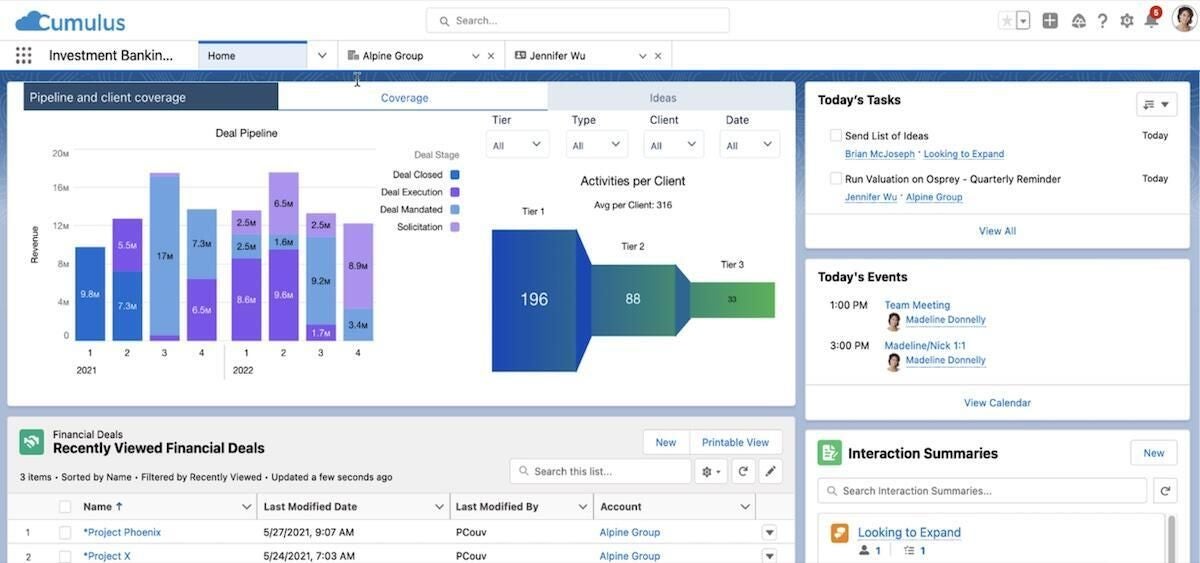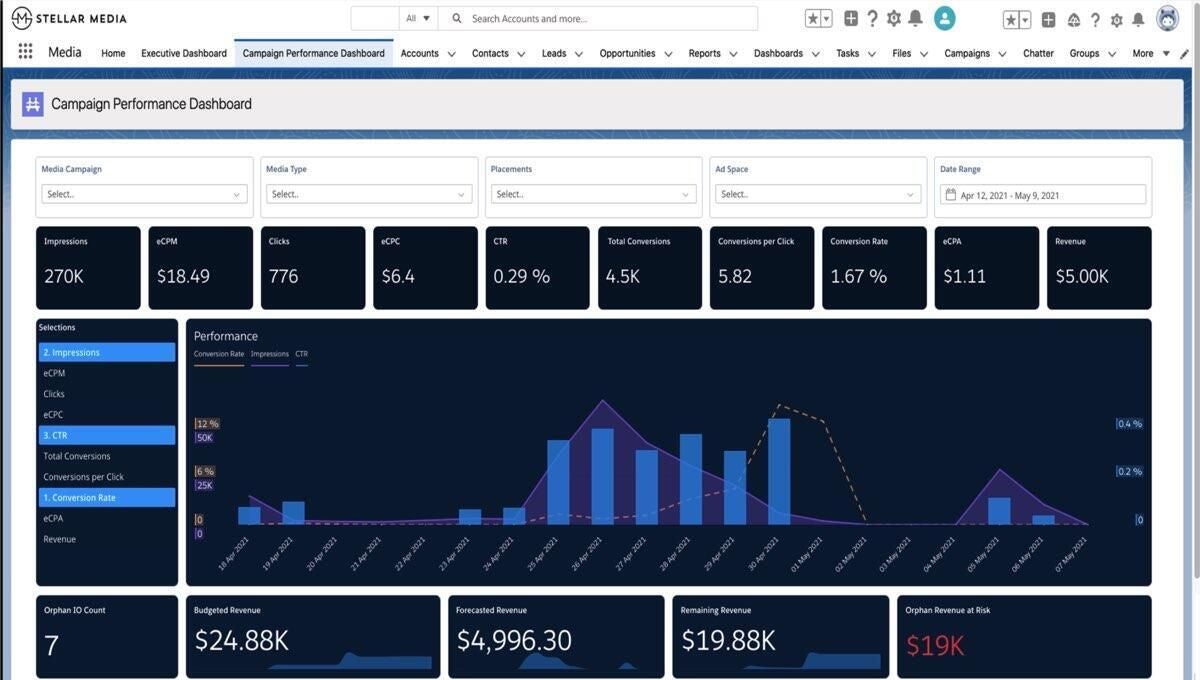During the Salesforce Industries Summit event in early June, the company announced Industry Success from Anywhere, a suite of new features for its business vertical solutions. Today, the cloud software company announced a new product for its Media Cloud called Advertising Sales Management for Media Cloud.
Like the company’s existing industry-vertical solutions, this latest offering is designed to solve a problem faced by a specific group of customers, in this case publishers that need to manage their ad campaigns across multiple channels. Advertising Sales Management for Media Cloud is already being used by publishers like Sony Pictures Networks India (SPNI).
“We understand the complexity that comes with managing advertising sales in today’s increasingly digital world, especially with publishers managing data across so many different advertising channels and formats,” said Christopher Dean, VP and GM, Media Cloud. “With Advertising Sales Management, Media Cloud’s new industry-specific application built natively on top of the Salesforce Customer 360 platform, we’re giving publishers one simple platform to help their teams manage everything in one place.”
During the Industries Summit event, I had a chance to speak with Jujhar Singh, Executive Vice President and General Manager for Salesforce Industry Clouds, about the new offerings, which include products for corporate and investment banking, retail, healthcare, and the public sector. We also discussed how Salesforce Industries fits into the company as a whole and what industries the company is looking to offer vertical solutions for in the future. The following is a transcript of our interview, edited for readability.
Salesforce is making deep investments in Industry Clouds
Bill Detwiler: So let’s talk a little bit about Salesforce Industries, right? You’re celebrating your fifth anniversary with Salesforce industries, and you’re having a summit this week to talk about, make some announcements to talk about some of case studies and with your customers. But, and I really want to talk about some of those announcements and how the products evolved. But before we get to that, I’d like to hear your take on what Salesforce industries is and how it fits within the company as a whole.

Image: Salesforce
Jujhar Singh: Excellent. Bill, we are a very customer focused company and the whole Salesforce Industry originated from our key focus on speaking the language of our customers in those industries. As a result, we started to invest heavily in Industries. We today have 12 industry-specific clouds, all built on the same platform as with 360. And these industry clouds are deep investments. We made investments across the complete layer from data model, to processes, to AI, to analytics, the whole elements are getting invested in. We don’t even stop at just building a higher level. For example, the financial services cloud. We actually make the investment at the sub-segment level. So we would have the offering for insurance, for wealth. And as you would hear some of the new segments that we are opening up for financial services cloud as part of the announcements, but we go to that level because each one of them has different nuances. And we make sure that we use it.
To your question, how it works with the rest of Salesforce. In fact, I would say we are extremely lucky to be being built on the Customer 360 platform…industry leading in sales, service, marketing, analytics, integration, all of that. We actually leverage all of that richness. We modify it. We extend it. We add to it. That’s how we keep building our Industries. Along with that, even our sales and go-to-market is also oriented industry-wise. More than 55% of our AEs are industry aligned. And we are also really keen on the ecosystem that we bring along with it. So we recently acquired Acumen. It’s a great addition, comes with great industry expertise. So for us, that industry expertise is not just on the product end, but across the whole spectrum.
Bill Detwiler: And industry clouds or industry specific cloud services have been around for several years now, like we were talking about with Salesforce industries. It’s your fifth anniversary. And it seems to be a growing trend. So some research that we did tech Republic in published just in 2019 showed that over 60% of companies were considering or using industry specific clouds. How has Salesforce industries evolved in that five years to take advantage of that growing interest in those industry specific, vertical specific clouds. And what are you doing to differentiate what you’re offering against some of the other people that are also playing in this space?
Jujhar Singh: Absolutely. We started our journey in 2016 when we launched financial services, cloud and healthcare. And today we have 16 releases, five years into building this. And that investment process kept on going on the organic side of the house in 2019. We launched three new clubs, manufacturing, consumer goods and public sector. And that focus of our in building industry specific clouds has spontaneity. We then did acquisitions. We acquired velocity. We also acquired.org, that added new industries. So when we added velocity, medication and media, energy and utilities were the new industries that got added to the mix.
And we enhance our financial services and health offerings.org brought in philanthropic cloud, nonprofit cloud as well as education. So now that whole journey actually brought in both organic as well as inorganic invest investments. Gave us 12 industry clouds, but all built on the same platform. And as I recently mentioned, our journey in acquiring acumen also added to the industry expertise in the whole team. So for us, this has been a journey for the past five years. The trend is hard. We love the fact. But for us, it was driven by our customers. And we believe it is a high growth area.
SEE: Return to work: What the new normal will look like post-pandemic (free PDF)
Helping industries succeed in a digital-first, post-pandemic world
Bill Detwiler: And it definitely has been over the last several years. And it seems like that’s going to continue. So at the summit this week, you’ve got a lot of announcements around industry clouds and you have a lot of new innovations coming out. Tell me about one of those, which is Industry Success from Anywhere.
Jujhar Singh: Yeah. So good question Bill. For us, the pandemic, if you look at it in aggressively changed the nature of business and customer impact 24 by seven digital support, tele-health, chatbots, curbside pickup. These are just some examples. But I believe is that with the pandemic gone away, the world is not going to change. Some of these things are going to carry forward. We believe that this year it’s a great growth opportunity. In fact, many industries will get re-imagined how they operate based on some of these accelerated digital transformation journeys that are there. And in taking care of these, what we have done during the industry summit, we are launching the industry success from India. We have launching multiple innovations for our industrial customers, but they fall into three major buckets. First one is leveraging industry, specific AI and compliance to help our customers work smarter. Secondly, second set of innovations help, excellent transformation from anywhere.

Image: Salesforce
Because we work now in a hybrid environment and we are doing it both for B2B and B2C customers. And thirdly imagination, which I said is a great opportunity. I believe it can change the space completely. So let me go deeper into each one of some of these investments that we are doing, the new innovations that are coming out. A great example, leveraging industry specific AI and the compliances at launch of corporate and investment bank. So as I mentioned, we are going into sub segments market and investment banking is a new subsegment that we are opening up for our financial services, investment bankers need digital tool to drive efficiency. They’re also trying to build and deepen relationships and then more deeds. They also required a single window, the amount of data to be brought in, integrated on one platform to help avoid mismanagement of things. So in order to take care of this, this is where we are investing in this new segment of corporate and investment banking.
We maximize the bankers efficiency and productivity. The entirety of the lifecycle can now be transacted. You can actually look at the historical client data, previous pitches, meeting notes, all in one place. And then we apply the power of our Tableau CRM. As I said, we apply the whole gamut of our offerings so that you actually can understand the whole D pipeline in a much better fashion. Where we are very excited as said, leveraging AI. We are using it to uncover relationships with AI-based research assistant, which we call Einstein Relationship Insights. And what it does is it new relationships we found, unanticipated. So it’s a relationship discovery tool. So if a bank that is actually working on in particular, D. He wants to not only find all the information about the account that he’s working on within the CRM system. He wants to know what’s happening on the web. What is happening in the social channels?
How can you bring all of that information and find unanticipated? So let’s say a prospective client, a new board member announcement comes out. You want to understand how is this new board member connected to some of your CRM existing clients? And how can you make a warm introduction. That type of expanding the universe through AI in understanding those unanticipated customer relationships is a big part. Compliance has a special category for corporate and investment banking. So think about investment banker. He has to leverage a whole team of experts who giving an opinion on something. But if he’s working on an acquisition, he can’t share that information. So we have built in those strict compliance rules, material non-public information, sharing rules right into the product. So that that process of compliance becomes extremely easy, but collaboration is also extremely easy at the same time. So that’s the uniqueness of the innovation that we are building. So making the process of compliance easy, why all the investment bankers can do collaboration very easy.
And finally leveraging data as a strategic asset is a big part of our offering. This is where investment banker logs into six or seven systems. How do you combine internal data from CRM, but also bring in partners such as SNP global for the financial information without less switching. So that’s one set up investment tied to what category of leveraging specific AI, industry-specific AI, as well as compliances. The second category, as I mentioned, pandemic is going to change things. We believe the world is going to be hybrid. This is where accelerating transformation from anywhere. We have launching specific investment, both in B2B and B2C. In B2B I’ll give you a good example for consumer goods.
We are launching what is called virtual retail execution. So if you think about a consumer good sales rep, he goes store to store to check whether all the products I put in the right place. He does those checks. In the pandemic you couldn’t go there. So in fact a new model was brought in with the retailers to a self-service would actually show their compliance and they will actually get incentives based from the consumer goods if they adopt that model. So in a B2B scenario, kind of we are picking the newer model and putting in an efficient, in much better, more efficient model rather than a sales rep going. I don’t think so. It is going to get completely replaced. But you now have a better model where some places the sales rep can go, but other places sell self-service…
Bill Detwiler: Oh, sorry. Go ahead.
Jujhar Singh: I still have a few more examples to talk about. It’s an exciting time for the innovations for that. But happy to answer in any detail questions.
SEE: Salesforce lays out its Cloud 3.0 strategy (TechRepublic)
What verticals are next on Salesforce’s roadmap for Industry Clouds?
Bill Detwiler: Well, no. I was going to ask, I think the investment banking and what you’re talking about with retail is really interesting here, because I’d love to get your take on how you select a specific vertical or a subsegment within a bigger category to introduce a new cloud four. I mean, how large does a vertical need to be before it gets its own cloud, or how unique maybe does a vertical have to be to get its own cloud? I mean, could you see multiple clouds within retail for an ice cream shop versus maybe a clothing shop, or you got food services versus some type of other, a consumer goods product or a small organizations by size stores by size. Just, I’d love to hear your thinking around that, of picking new categories to expand into.
Jujhar Singh: Great questions. So, first of all, biggest driver for what verticals we go into is driven by our customers. So that’s our biggest strength. The second set of things that we look at is in a given. So if you think about that evolution, we first came out with horizontal offerings or sales or marketing. We then actually also look at, Hey, are the domains where our existing offerings are a great fit. So we don’t need to play industry specific sauce on top of it. That becomes our second one. Then the third is in the industries which have high growth potential. That becomes another area of investment.

Image: Salesforce
Lastly, when we try to figure out how deep are we going to go? So this is where I was talking about going to sub segments as well. In certain cases, the sub segment functional footprints are very similar. In other cases, when you go to, for example, a insurance offering, versus is a wealth offering, versus the corporate investment banking offering, the nuances and the differences are a way for, they’re far more pertinent. We actually ended up building at the subsidiary level. So it depends upon these multiple criteria for us to make the decision where to go. But customers are always our top drivers, which guide us where to go.
Bill Detwiler: And I was going to say, and that takes me to my next question, which is, what can we expect from Salesforce industries over the next year or two?
Jujhar Singh: Great question. So I would say, and I’ll give you in the context of some of the innovations that we are doing. I think for us, one of the pillars I was talking about reimagination. While others are just focused on putting better digital processes, our focuses on reimagination. So as part of some of the new innovations that we are doing, and I’ll take another consumer goods example. So in consumer goods industry, a lot of the money is spent on trade promotions. In fact, 25% of the revenue is spent on that. Almost 90% of the overall elements flow through the trade side of the house rather than direct consumer. In this case, the planning and execution actually happened in silos. They happen in different systems. So with this new industry success from anywhere, we are actually announcing trade promotions management, where we are bringing planning and execution all based on one platform.
So our thought process, every industry we go into Bill is, how can we reimagine it? So this is a great case of reimagination by breaking down the silos. Another good example of reimagination for us is also, if you think about all of us interact with government, federal, state, civil, a lot of transformation, quick transformation has happened with pandemic, vaccine management or contact tracing, all of these elements happen. But at the heart of it, that exhalation is going to stay for a long time in the new enhancements that we are doing. We are also talking about intelligent document automation for public sector. So in a lot of the applications that we feel are true paper applications, how do you take a paper application very quickly digitize it using AI so that the employees of the government are putting much more time on solving the citizens problem rather than doing this, rather than just taking and transcribing what is written in applications into system.
So that process of automation of re-imagining how you can bring better transparency, better digital acceleration on public sector organizations is also part of the announcement that we do. But for us, reimagination is a big team, whether through AI, whether through breaking the silos or even business models. So in fact, we have great examples where we end up using different pricing models for insurance. We use gross written premiums. In fact, on one other element of reimagination is how we build a product. So if you think about normal industry products, they are all built for one customer at a time servicing their needs. But industry actually wants to cooperate on certain elements, which may be useful for all the players in the industry. They compete in certain elements.
And this is where our investment in many too many exchanges. We have multiple players coming together, solving the needs of the industry becomes extremely important. So philanthropic cloud, one of our industry clouds is a great example of many exchange where multiple companies come together to actually have a marketplace of causes on the one hand. But then from a employees perspective, it is very unique. Because the employee can actually take this profile from one and move it to another. So this is where we are trying to create the next set of differentiation, but reimagination is front and center. Success from anywhere in this hybrid environment is very key to us.
